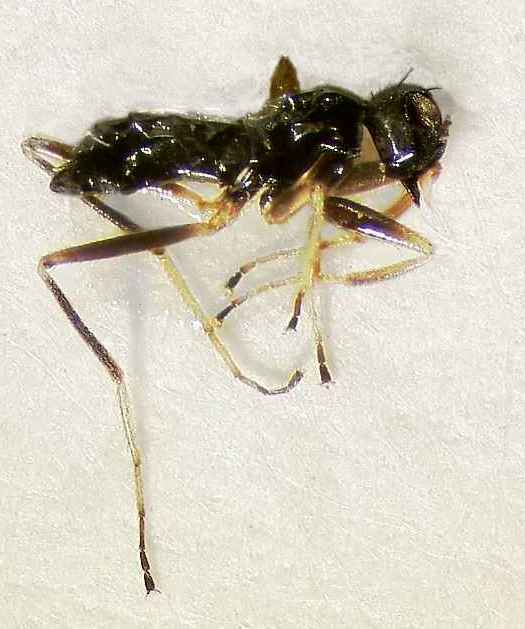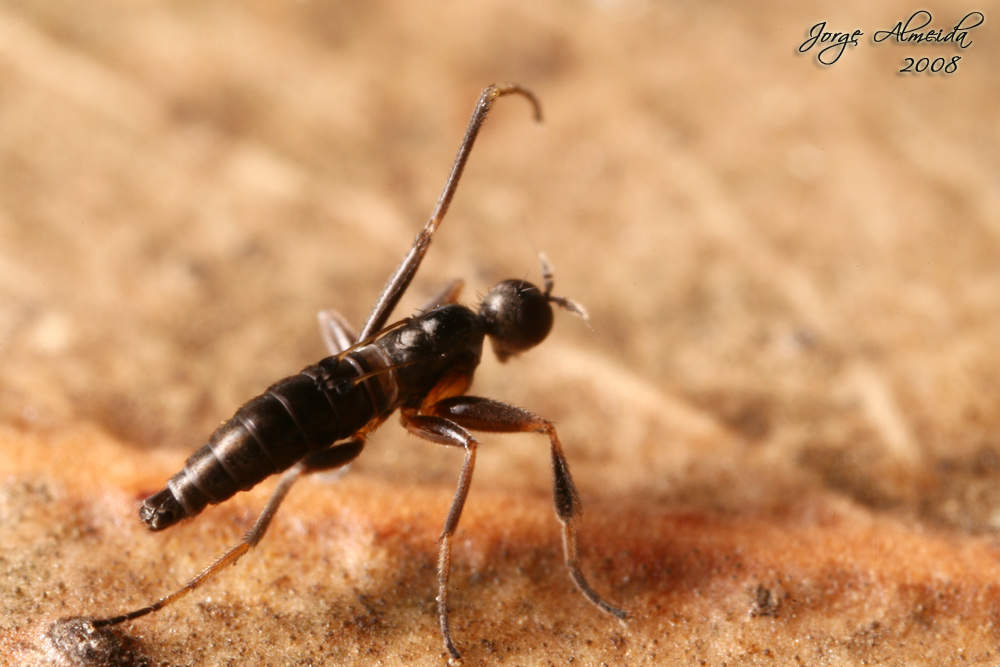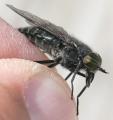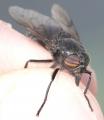Diptera.info :: Identification queries :: Diptera (adults)
Who is here? 1 guest(s)
|
Ariasella lusitanica, Hybotidae
|
|
| jorgemotalmeida |
Posted on 09-03-2008 21:05
|
|
Member Location: Viseu - PORTUGAL Posts: 9296 Joined: 05.06.06 |
or T. andradae...  |
| Rui Andrade |
Posted on 09-03-2008 23:12
|
|
Member Location: Portugal Posts: 3123 Joined: 19.06.07 |
LOL Or, for example, T. dipterainfoi, in honour of all who contribute to make this forum the best  Theo raised in this thread (http://www.dipter...post_54568) the question of what the tachinid was doing. I have in the photo below the hybotid doing the same thing:  |
| jorgemotalmeida |
Posted on 09-03-2008 23:21
|
|
Member Location: Viseu - PORTUGAL Posts: 9296 Joined: 05.06.06 |
those white things are interesting!! I must go to Barcelos next weekend! Hopefully it will not rain. Maybe they are pollen grains. It would explain a lot of things.  Palinology would answer this one. 
Edited by jorgemotalmeida on 10-03-2008 01:04 |
| Adrian |
Posted on 11-03-2008 13:01
|
|
Member Location: Posts: 69 Joined: 05.01.07 |
This species looks similar to T apterygon described from Italy by myself and John Deeming. However, yours has vestigial wings and the Italian sp hasn't even a trace of a wing or halter. It will be interesting to hear what Igor makes of it I'd attach a photo if I new how cheers Adrian |
|
|
|
| Paul Beuk |
Posted on 11-03-2008 14:31
|
|
Super Administrator Location: Netherlands Posts: 19403 Joined: 11.05.04 |
Adrian, If you want to attach an image, use the 'Post Reply' button just above the 'Quick Reply' box. Instructions are in the FAQ. Igor and I assume this will be a new species but we think it will be necessary at least to add the genus Pieltania to that equation. Together with Patrick Grootaert we will look in to this. Adrian, if you have a pdf of your paper, I'd be happy to receive a copy/pdf (or at least a reference) so we can add that one into the equation as well. To that marvelous Portuguese lot out here, the request to collect as many as possible pictures and biological data. Even in the case it does not prove to be anew species, this is an excellent opprotunity to get to know more about this remarkable species. Paul - - - - Paul Beuk on https://diptera.info |
| jorgemotalmeida |
Posted on 11-03-2008 14:35
|
|
Member Location: Viseu - PORTUGAL Posts: 9296 Joined: 05.06.06 |
Paul Beuk wrote: Adrian, If you want to attach an image, use the 'Post Reply' button just above the 'Quick Reply' box. Instructions are in the FAQ. Igor and I assume this will be a new species but we think it will be necessary at least to add the genus Pieltania to that equation. Together with Patrick Grootaert we will look in to this. Adrian, if you have a pdf of your paper, I'd be happy to receive a copy/pdf (or at least a reference) so we can add that one into the equation as well. To that marvelous Portuguese lot out here, the request to collect as many as possible pictures and biological data. Even in the case it does not prove to be anew species, this is an excellent opprotunity to get to know more about this remarkable species. Hopefully this weekend I will go to the place and with Andrade I will take photos and observe the ethology of these beauties.  |
| igor |
Posted on 11-03-2008 20:21
|
|
Member Location: Posts: 297 Joined: 23.11.06 |
Dear Adrian, Because this peculiar species has attracted so much attention I would like to give some broader comments. 1. Your fine species from Italy can be readily distinguished from this species by wings and halteres completely absent (as you have noted), pale yellow palpi, colour of legs and some other characters. 2. I placed this species within Tachydromia but, following current systematic of Tachydromiinae, the species should be placed within Pieltainia Arias, 1919. Arias erected this monotypic genus owing to lack of wings and halteres in his species. So, I believe that Pieltainia is likely a synonym of Tachydromia. Hopefully, at the nearest time, we will discuss this situation as Paul have noted. 3. This species vs. Pieltainia iberica Arias, 1919. According to these pics this species is very similar to Pieltainia iberica Arias, 1919 [described from Cala, provincia de Huelva (Spain)]. However, Portuguese species has vestigial wings (in male only?) and slight differences in legs colour. It is interesting to note that P. iberica was found in early spring actively running about in pursuit of Sciaras and other microscopic Diptera on which it preyed. All the best,  Igor |
|
|
|
| Rui Andrade |
Posted on 11-03-2008 23:00
|
|
Member Location: Portugal Posts: 3123 Joined: 19.06.07 |
Now I'm curious about the biology (ecology, ethology, etc...) of Tachydromia in general. For example, what do the larvae feed on? How could this species' male use its vestigial wings? And so on. |
| igor |
Posted on 11-03-2008 23:27
|
|
Member Location: Posts: 297 Joined: 23.11.06 |
Dear Rui, Species of the genus Tachydromia Meigen are quite small, shining black or blackish brown, usually have wings with brown pattern and are found running about quickly on tree-trunks, logs, stones, sand, or leaves of lower herbage resembling in some respects small hymenopterans or ants (Chvála, 1970). The group is almost worldwide in distribution (unknown from Australia) and currently includes 107 species (Shamshev & Grootaert, in press). Nothing is known about larvae of these flies. |
|
|
|
| jorgemotalmeida |
Posted on 11-03-2008 23:37
|
|
Member Location: Viseu - PORTUGAL Posts: 9296 Joined: 05.06.06 |
You are so near from the local. Lucky you!  Vestigial wings: it can be explained according to the ecology of these flies. As they were adapted to the ground life, the ascendents of these flies take off the wings as they were not so used. remember that evolution don't pursue an objectif. |
| Rui Andrade |
Posted on 11-03-2008 23:41
|
|
Member Location: Portugal Posts: 3123 Joined: 19.06.07 |
Thank you Igor It seems that there is a lot to discover within this genus. In what concerns me I'll try to gather more information. I don't know if it's important, but I have collected the prey (the sciarid) of the male Tachydromia. |
| Rui Andrade |
Posted on 11-03-2008 23:44
|
|
Member Location: Portugal Posts: 3123 Joined: 19.06.07 |
jorgemotalmeida wrote: You are so near from the local. Lucky you!  Vestigial wings: it can be explained according to the ecology of these flies. As they were adapted to the ground life, the ascendents of these flies take off the wings as they were not so used. remember that evolution don't pursue an objectif. I asked that because the females don't have wings. If the females don't have wings, why do the males? |
| jorgemotalmeida |
Posted on 12-03-2008 00:26
|
|
Member Location: Viseu - PORTUGAL Posts: 9296 Joined: 05.06.06 |
remember that usually males move a lot their wings to impress the females. Maybe with the latter change in a population of Tachydromia could trigger that loose of wings due the style of life. Maybe now with these male hybotids they can impress their females with an offering of a prey. Of course, these are only hypothesis and they could be wrong. Very soon we will know some answers.  |
| Adrian |
Posted on 14-03-2008 13:37
|
|
Member Location: Posts: 69 Joined: 05.01.07 |
Here at last is the image of T. apterygon from Italy:- clearly different from your sp. We still have a great deal to find out about this genus:- even in Europe cheers Adrian Adrian attached the following image:  [30.84Kb] |
|
|
|
| jorgemotalmeida |
Posted on 14-03-2008 14:29
|
|
Member Location: Viseu - PORTUGAL Posts: 9296 Joined: 05.06.06 |
unfortunately, this weekend will rain and we cannot see these flies in action.  About the size: what is the size for T. apterygon ? For those lusitanic Tachydromia are about 2 mm - 3 mm. |
| Paul Beuk |
Posted on 14-03-2008 15:15
|
|
Super Administrator Location: Netherlands Posts: 19403 Joined: 11.05.04 |
Dry-mounted holotype male: 2 mm
Paul - - - - Paul Beuk on https://diptera.info |
| Adrian |
Posted on 14-03-2008 15:23
|
|
Member Location: Posts: 69 Joined: 05.01.07 |
T. apterygon is c 2mm long. (see Plant & Deeming Int. J. Dipterol. Res 17(1) 13-16 2006). The type locality is a steep mountain slope at 1400m in the Appenine Mountains of Italy at the edge of alpine meadow and deciduous woodland. A single male was found on the ground layer of stones and organic rubbish (how I envy the numbers you are finding in Portugal!) To my knowledge brachyptery (loss of wings) is only otherwise known in T rossica (described by Igor from Mongolia) while T. brevipennis & T schnitteri have greatly reduced wings. Considering the large number of Tachydromia and their cursorial habits, it is perhaps no surprise that another one has been found. Maybe we should all be searching the ground in mountain areas and might find a few more? The question of mating habits was raised earlier. I suggect that Tachydromia has more a 'grab and rape' strategy rather than a more complex display component. The related genus Tachypeza sometimes has strange marks on the front legs and these might possibly be used in displaying to females (especially likely as these markings are lacking in the female). However, Tachypeza has more bland fore legs so I still support the grab & rape hypothesis. Good luck with finding out more about this species:- and if you have any spare specimens............. cheers Adrian |
|
|
|
| Rui Andrade |
Posted on 14-03-2008 21:12
|
|
Member Location: Portugal Posts: 3123 Joined: 19.06.07 |
Adrian, thank you for posting the image of T. apterygon. Barcelos' Tachydromia are 2 mm long as well. I'm very curious about the mating rituals. In the last weekend, I put together one female and one male to see if something happened but they ignored each other  . . Unfortunately I can only go the place during the weekends and in the next one it will be raining  . . |
| jorgemotalmeida |
Posted on 16-03-2008 01:06
|
|
Member Location: Viseu - PORTUGAL Posts: 9296 Joined: 05.06.06 |
NEWS:  Today me, Andrade and him brother went to the famous local of the new hybotid. True: there are plenty of them. And today we found mainly... males!  And a very special occasion: copula. And a very special occasion: copula.  yes, we took videos, photos, and observed the spectacular and hilariant phenomenon!  I will tell more details soon. I will tell more details soon.Andrade will upload photos right now. I will upload more in one hour. And it will be available in youtube superegnum (my account) those videos..  With copula included...  Be tunned!  Highly strange the way this flies use their legs as you can see in the next photo. like an acrobat... As you can see in Andrade's photos the male NEVER moved during all the copula!!! LOL (I will write more later about this.) jorgemotalmeida attached the following image:  [190.34Kb] Edited by jorgemotalmeida on 16-03-2008 03:21 |
| Rui Andrade |
Posted on 16-03-2008 01:08
|
|
Member Location: Portugal Posts: 3123 Joined: 19.06.07 |
Here are my photos from today:   |
| Jump to Forum: |













